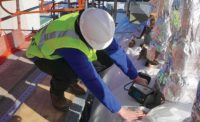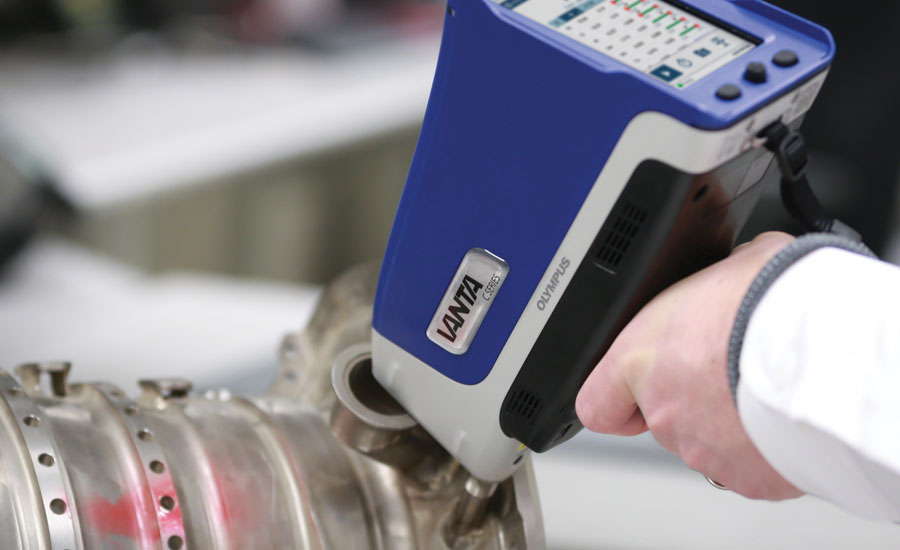Handheld XRF Analyzers are Fast, Accurate, and Indispensable
Ted Shields, portable products manager at Olympus, and Jiyan Gu, product manager of handheld XRF at Bruker, detail the various advances in X-ray Fluorescence (XRF) technology.

Vanta handheld portable XRF analyzers provide fast elemental analysis and alloy identification in the field, and are rugged to maximize uptime. Source: Olympus

The S1 TITAN line of handheld XRF analyzers include integrated touch-screen color displays, 50 kV X-ray tubes, and, SharpBeam optimized X-ray geometry. Source: Bruker


It’s an exciting time to work in nondestructive testing (NDT) for aerospace, particularly now that significant strides in NDT techniques have transformed how the industry approaches aircraft maintainability and safety. One of these advances is the more widespread use and development of X-ray Fluorescence (XRF) technology, specifically in the use of handheld, portable XRF analyzers to inspect, evaluate, and monitor aircraft.
Recently, Quality spoke to two experts on the subject of XRF analyzers —Ted Shields, portable products manager, analytical instruments division at Olympus Scientific Solutions Americas; and Jiyan Gu, product manager, handheld XRF at Bruker Corporation—to get their takes on the technology and what to expect from it in the not-so-distant future.
Basic benefits
“XRF is a great nondestructive technique to help ensure that the right materials are being used,” Shields says. For the uninitiated, XRF tests for material composition, while other NDT techniques (ultrasound, eddy current) test for physical integrity. If a part is not made out of the material specified, Shields explains, then it can fail unexpectedly —and that type of failure is obviously unacceptable in the aerospace industry.
“Material mix-ups happen despite the best efforts to avoid them,” Shields continues. “It can be a vendor mislabeling something or a part put back in stock in the wrong bin. Since many materials look the same, the only way to know you have the correct material is to test it.”
Handheld XRF gets results in seconds, he notes, so you can determine if you have the correct material instantaneously.
“This makes XRF ideal for both incoming QC and inspecting installed parts,” Shields explains. “As long as the sample tested is clean and uncoated, the samples do not require preparation.”
For example, Bruker’s S1 TITAN series of XRF analyzers provide, according to Jiyan Gu, “quick and accurate material characterization to ensure strict chemical composition specifications are met.” Consequently, he says, aircraft engineers can distinguish, in a matter of seconds, aluminum alloy grades that are almost identical in chemical composition.
“XRF analyzers are handheld, portable, and require little to no test sample preparation,” Gu reiterates, adding that “the latest improvements in handheld alloy analyzers for aerospace alloy testing have resulted in smaller, faster, and near-lab performance analysis in a light, field-hardened package.”
Quickness and accuracy
When ensuring that chemical composition specifications are being met, the fastest solution may not be the most accurate, and vice versa. Of course, safety is most important when it comes to building and maintaining the structural integrity of aircraft; but quicker evaluation without sacrificing accuracy is a win-win for NDT technicians and the customers they serve. Thus, Gu says, Bruker prioritizes working closely with their aerospace customers as they continue to develop “faster and more accurate handheld analyzers” to meet the most demanding analytical requirements.
“The newest aerospace structures and materials require close manufacturing evaluation, and in-service aircraft need careful inspection and monitoring,” Gu says. “Today, Bruker has a comprehensive handheld XRF product line for different aerospace NDT applications, from quality control to advanced material research.”
Another example is Olympus’ Vanta model of XRF analyzers, which comes equipped with the company’s Axon technology and, as Shields describes, “optimizes our X-ray detector and signal processing so we can count more X-rays and count them faster.” More X-rays means greater sensitivity, he explains, and the higher X-ray count really pays off for aluminum and titanium alloys.
“Aerospace applications focus on either lightweight materials, such as aluminum and titanium alloys, or temperature-resistant alloys, such as nickel alloys,” Shields says. “The lightweight materials have historically been challenging for XRF; Vanta analyzers solve that problem with Olympus’ Axon technology.”
“For nickel alloys,” he continues, “Axon technology provides excellent precision and resolution, so we can distinguish between alloys with similar content.”
Safety and quality assurance
Crucially, XRF provides an additional layer of quality assurance required for airworthiness. As Gu notes, the combination of the proper performance of aircraft components and material verification for aerospace materials is critical, as a material mix-up can have disastrous consequences.
“For the aerospace industry, portable XRF technology has greatly assisted in improving quality control,” Gu says. “Handheld XRF can be utilized for eliminating misidentified incoming material, inventory mixes, and QA/QC of the final product.”
In the instance of aircraft fasteners, Gu says, the application of XRF handhelds is twofold.
“First, the device is used to analyze incoming raw material, verifying it matches the alloy grade and composition prior to product manufacture,” he explains. “Second, the instrument acts as an added layer of quality assurance, used in the final inspection before the product is sent to the customer.”
This redundancy helps prevent costly or even catastrophic consequences, and verifies that the finished parts meet strict safety regulations.
“XRF analyzers are invaluable tools for performing positive material identification (PMI) for aircraft NDT, regardless of the production stage,” Gu says. “From raw materials to works in progress to finished parts, XRF handhelds provide an added layer of quality assurance for the aviation industry.”
The future of XRF
Last September, Olympus simultaneously released the Vanta analyzer and software that Shields says makes it easier for clients with more than one instrument to set up all of their analyzers with the same settings configuration. This “fleet management,” as he refers to it, helps ensure consistent results from inspector to inspector and across facilities.
“Our software department is developing new features that we’ll be talking about in the fall,” Shields says, in regard to leveraging the analyzer’s optional Wi-Fi connectivity. He also says that, as part of a smart manufacturing facility, the Vanta analyzer can transport data to wherever the decision maker is, through the release of the so-called Olympus Scientific Cloud.
Via the Cloud, “users will be able to auto-export results to network folders and share the analyzer’s screen on mobile devices,” Shields says. He adds: “We want to make it as simple as possible to integrate the Vanta analyzer with your workflow and data management system.”
At Bruker, the new TRACER 5i pXRF spectrometer complements Bruker’s S1 TITAN line of handheld XRF analyzers; and, as Gu explains, “is designed for customers who need both point-and-shoot analysis as well as more specialized analysis.” It incorporates a more powerful tube and a detector for improved accuracy and sensitivity, and includes many advanced features such as small spot analysis, pressure and temperature compensation, and Wi-Fi connectivity. The spectrometer also allows the user to develop their own calibrations for specialty alloys, coatings, and non-metallic materials. As Gu summarizes, the TRACER “allows complete user control of the measurement conditions.”
Insofar as customizability, cloud-based interconnectivity, and real-time data underpin what has been called the Fourth Industrial Resolution, XRF, at least in the NDT sphere, remains in the vanguard. When it comes to what’s next, the experts agree: sky’s the limit.
Looking for a reprint of this article?
From high-res PDFs to custom plaques, order your copy today!









